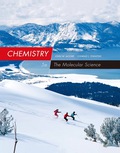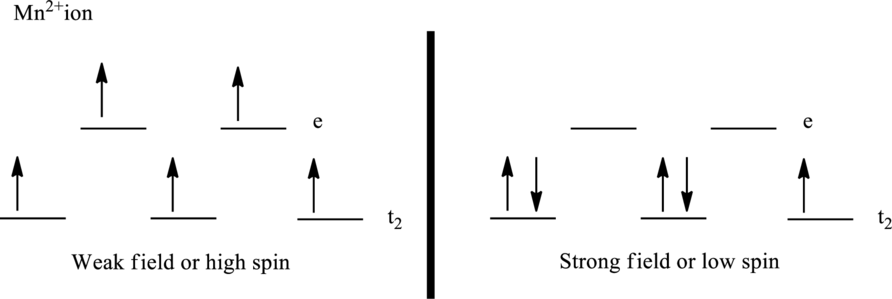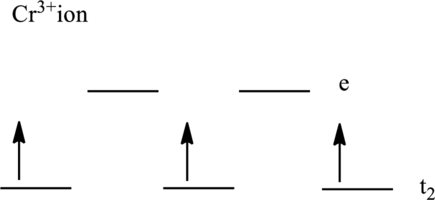
Concept explainers
(a)
Interpretation:
Number of unpaired electrons in
(a)
Explanation of Solution
Given complex ion is

Number of unpaired electrons:
The ligand that is present in the complex is water. Water is a weak field ligand. Therefore, it forms high spin complex. From the above drawn crystal field model, it is found that there are four unpaired electrons in high-spin complex.
(b)
Interpretation:
Number of unpaired electrons in
(b)
Explanation of Solution
Given complex ion is

Number of unpaired electrons:
The ligand that is present in the complex is water. Water is a weak field ligand. Therefore, it forms high spin complex. From the above drawn crystal field model, it is found that there are five unpaired electrons in high-spin complex.
(c)
Interpretation:
Number of unpaired electrons in
(c)
Explanation of Solution
Given complex ion is

Number of unpaired electrons:
The ligand that is present in the complex is fluorine. Fluorine is a weak field ligand. Therefore, it forms high spin complex. From the above drawn crystal field model, it is found that there are five unpaired electrons in high-spin complex.
(d)
Interpretation:
Number of unpaired electrons in
(d)
Explanation of Solution
Given complex ion is

Number of unpaired electrons:
The ligand that is present in the complex is ethylenediamine. From the above drawn crystal field model, it is found that there are three unpaired electrons in complex.
Want to see more full solutions like this?
Chapter 20 Solutions
EBK CHEMISTRY: THE MOLECULAR SCIENCE
 Chemistry: The Molecular ScienceChemistryISBN:9781285199047Author:John W. Moore, Conrad L. StanitskiPublisher:Cengage Learning
Chemistry: The Molecular ScienceChemistryISBN:9781285199047Author:John W. Moore, Conrad L. StanitskiPublisher:Cengage Learning Chemistry: Principles and PracticeChemistryISBN:9780534420123Author:Daniel L. Reger, Scott R. Goode, David W. Ball, Edward MercerPublisher:Cengage Learning
Chemistry: Principles and PracticeChemistryISBN:9780534420123Author:Daniel L. Reger, Scott R. Goode, David W. Ball, Edward MercerPublisher:Cengage Learning Chemistry & Chemical ReactivityChemistryISBN:9781133949640Author:John C. Kotz, Paul M. Treichel, John Townsend, David TreichelPublisher:Cengage Learning
Chemistry & Chemical ReactivityChemistryISBN:9781133949640Author:John C. Kotz, Paul M. Treichel, John Townsend, David TreichelPublisher:Cengage Learning Chemistry & Chemical ReactivityChemistryISBN:9781337399074Author:John C. Kotz, Paul M. Treichel, John Townsend, David TreichelPublisher:Cengage Learning
Chemistry & Chemical ReactivityChemistryISBN:9781337399074Author:John C. Kotz, Paul M. Treichel, John Townsend, David TreichelPublisher:Cengage Learning Chemistry: An Atoms First ApproachChemistryISBN:9781305079243Author:Steven S. Zumdahl, Susan A. ZumdahlPublisher:Cengage Learning
Chemistry: An Atoms First ApproachChemistryISBN:9781305079243Author:Steven S. Zumdahl, Susan A. ZumdahlPublisher:Cengage Learning ChemistryChemistryISBN:9781305957404Author:Steven S. Zumdahl, Susan A. Zumdahl, Donald J. DeCostePublisher:Cengage Learning
ChemistryChemistryISBN:9781305957404Author:Steven S. Zumdahl, Susan A. Zumdahl, Donald J. DeCostePublisher:Cengage Learning





